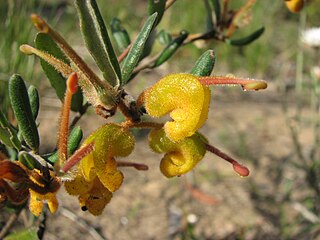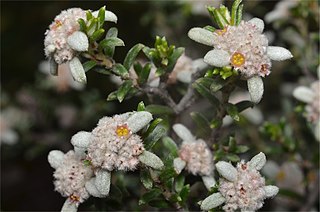
Eucalyptus cladocalyx, commonly known as sugar gum, is a species of eucalypt tree found in the Australian state of South Australia. It is found naturally in three distinct populations - in the Flinders Ranges, Eyre Peninsula and on Kangaroo Island.

Olearia teretifolia, commonly known as cypress daisy-bush, is a species of flowering plant in the family Asteraceae and is endemic to south-eastern continental Australia. It is a slender, erect to spreading shrub with more or less sessile, linear leaves pressed against the stem, and white and yellow, daisy-like inflorescences.

Grevillea chrysophaea, commonly known as golden grevillea, is a species of flowering plant in the family Proteaceae and is endemic to Victoria in Australia. It is a spreading shrub with oblong to almost linear leaves, and dull to golden yellow flowers with a red or orange-red style.

Prostanthera striatiflora, commonly known as jockey's cap, striated mintbush or striped mintbush, is a species of flowering plant that is endemic to the more arid areas of Australia. It is an erect, aromatic shrub with narrow egg-shaped to narrow elliptic leaves and white flowers with purple lines inside the petal tube.

Billardiera sericophora is a species of flowering plant in the family Pittosporaceae and is endemic to the south-east of South Australia. It is spreading shrub or climber that has mostly narrowly elliptic leaves and pendent yellow flowers arranged singly or in pairs.
Cassinia × adunca is a species of flowering plant in the family Asteraceae and is endemic to South Australia. It was first formally described in 1853 by Otto Wilhelm Sonder in the journal Linnaea: ein Journal für die Botanik in ihrem ganzen Umfange, oder Beiträge zur Pflanzenkunde from an unpublished description by Ferdinand von Mueller. It is considered to be a hybrid, possibly between Cassinia complanata and C. tegulata.

Acacia aciphylla is a species of flowering plant in the family Fabaceae and is endemic to the south-west of Western Australia. It is a bushy, prickly shrub with down-turned, rigid, sharply-pointed phyllodes, flowers arranged in a oval heads usually arranged in pairs in leaf axils, and linear pods up to 90 mm (3.5 in) long.

Isotoma petraea, commonly known as rock isotome, is a small, herbaceous plant in the family Campanulaceae occurring in arid regions of Australia. It has single, purplish-blue flowers on smooth, slender branches from February to November.

Sarcozona praecox, commonly known as sarcozona, is species of flowering plant in the family Aizoaceae and is endemic to Australia. It is a small erect to low-lying, succulent shrub with leaves that are triangular in cross-section and arranged in opposite pairs, and daisy-like flowers with twenty to eighty pink, petal-like staminodes and 20 to 150 stamens.

Goodenia calcarata, commonly known as streaked goodenia, is a species of flowering plant in the family Goodeniaceae and is endemic to Australia. It is an erect, annual herb with toothed egg-shaped to oblong leaves, racemes of white, cream-coloured or pink to mauve flowers with brownish markings, and oval fruit.

Arabidella is a genus of flowering plants belonging to the family Brassicaceae. It was first described in 1853 by Ferdinand von Mueller as a subgenus of Erysimum to give the name, Erysimum subg. Arabidella, but was elevated to genus status by Otto Eugen Schulz in 1924. The type species is Arabidella trisecta.

Olearia muelleri, commonly known as Mueller daisy bush, Mueller's daisy bush or Goldfields daisy, is a species of flowering plant in the family Asteraceae and is endemic to southern continental Australia. It is a compact or spreading shrub with scattered spatula-shaped to egg-shaped leaves with the narrower end towards the base, and white and yellow, daisy-like inflorescences.
Pomaderris flabellaris, commonly known as fan pomaderris, is a species of flowering plant in the family Rhamnaceae and is endemic to South Australia. It is a low shrub with fan-shaped leaves, and small clusters of woolly-hairy flowers.
Olearia picridifolia, commonly known as rasp scrub-daisy, is a species of flowering plant in the family Asteraceae and is endemic to southern continental Australia. It is a low, spreading shrub with narrowly egg-shaped or narrowly elliptic leaves, and blue, mauve or white and yellow, daisy-like inflorescences.

Spyridium leucopogon, commonly known as silvery spyridium, is a species of flowering plant in the family Rhamnaceae and is endemic to the Eyre Peninsula in South Australia. It is a small, slender shrub with narrowly linear leaves, and heads of woolly, white flowers.

Arabidella trisecta is a species of flowering plant belonging to the family Brassicaceae. It was first described in 1853 by Ferdinand von Mueller as Erysimum trisecta, but was transferred to the genus, Arabidella in 1924 when by Otto Eugen Schulz elevated Mueller's subgenus Arabidella to genus status. No type specimen was indicated by Mueller in 1853, and in 1965 Elizabeth A. Shaw specified the lectotype as MEL 758 and a paralectotype MEL 0000778A, both collected by Mueller from Spencers Gulf in South Australia.

Abutilon halophilum is a flowering plant in the family Malvaceae. It is a small understory shrub with yellow or cream-white flowers and hairy oval-shaped leaves and grows in New South Wales, South Australia and the Northern Territory.

Xanthosia leiophylla is a tufted herb or weak subshrub in the family Apiaceae and is endemic to south-eastern continental Australia. It has bifoliolate or trifoliate leaves and 2 to 4 rays with up to 3 reddish flowers.
Swainsona luteola is a species of flowering plant in the family Fabaceae and is endemic to the eastern Australia. It is a prostrate or low-lying to semi-erect perennial with imparipinnate leaves with usually 3 to 17 narrowly elliptic leaflets, and racemes of 5 to 15 purple, sometimes yellow flowers.
Swainsona plagiotropis, commonly known as red swainsona-pea is a species of flowering plant in the family Fabaceae and is endemic to eastern continental Australia. It is a prostrate or ascending perennial herb with imparipinnate leaves with 13 to 25 narrowly egg-shaped or narrowly lance-shaped leaflets and racemes of 2 to 5 reddish-purple flowers.















